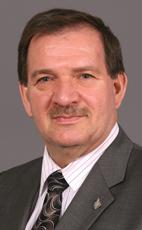Mr. Speaker, I am particularly pleased to take part in today's discussion on Bill C-298 introduced by the hon. member for Beaches—East York.
My goal is to illustrate the importance of this bill for protecting the environment and for the health of Quebeckers and Canadians.
This chemical, referred to as perfluorooctane sulfonate or PFOS, is one of the many threats to the health of current and future generations.
PFOS is part of the perfluorinated compounds, or PFCs.
The four non-metallic elements in the halogen group are chlorine, fluorine, bromine, and iodine.
Many common products contain chlorine. Just look at PCBs alone, including organochlorine pesticides such as aldrin, chlordane and mirex.
Many common products also contain fluorine. Take for example all the compounds eliminated from air conditioners and refrigerators that were affecting the ozone layer.
Now it is PFOS that needs our attention and review.
Its anti-adhesive, anti-stain and impermeable properties are very attractive for manufacturers of new products and new clothing.
Among the large number of consumer products that may contain PFOS, there are carpets, fabrics, upholstery, food packaging, cleaning products and industrial and domestic stain removers. Everyone has had or still has ScotchgardTM made by 3M.
All these consumer products can already be found in our homes and their numbers are likely to grow in the future, given that there are currently very attractive designer garments and quality material treated with PFOS in Chinese, Korean, Taiwanese and South-East Asian factories. More products will mean more imports and more skin contact with PFOS.
We are talking about a persistent, bioaccumulative and intrinsically toxic substance, according to an annex to the document published by the Department of the Environment and the Department of Health containing the results of a survey and recommendations on PFOS. The conclusion of that document, published in the Canada Gazette, does state:
Based on available information for ecological considerations, it is concluded that PFOS...meet the criterion set out in paragraph 64(a)—
Paragraph 64(a) reads as follows:
64. —a substance is toxic if it is entering or may enter the environment in a quantity or concentration or under conditions that
(a) have or may have an immediate or long-term harmful effect on the environment or its biological diversity;
Examples of presence of PFOS in the environment can be found readily in the literature. Evidence of the presence of PFOS even in the blood and liver of the polar bear confirms that the environment has been contaminated by this substance, that this substance is persistent, that it travels, that it is bioaccumulated and, worse yet, that it is bioamplified through the food chain, from the fish to the seal to the polar bear, all the while increasing in concentration. That is what is called bioamplification.
What about humans?
Our first surprise came from a document entitled “Polluted Children, Toxic Nation: A Report on Pollution in Canadian Families”. This document by an organization called Environmental Defence reveals the results of laboratory tests conducted on 13 volunteers of various ages: six adults and seven children. Of the 68 chemicals studied, 46 were detected in 13 volunteers, 32 products on average in the parents and 23 in the seven children.
Thirty-eight of these chemicals are carcinogens, 23 are hormone disruptors, 12 are respiratory toxins, 38 are reproductive or developmental toxins, and 19 are neurotoxins.
Five of the 13 perfluorinated chemicals targeted by the study were detected, including four in the children and five in the adults. Two perfluorinated chemicals were detected in all of the volunteers, namely, PFOS and PFOA.
The median concentrations of the perfluorinated chemicals was 13.5 micrograms per litre among the 6 adults, compared to 13.8 among the children, which is what inspired the title of the report, “Polluted Children, Toxic Nation: A Report on Pollution in Canadian Families”.
In addition to the shocking news revealed in the Environmental Defence group report, the Standing Committee on the Environment and Sustainable Development received another shock during the meeting of October 19, 2006. The testimony of Kenneth Cook, president of the Washington, D.C., office of the Environmental Working Group (U.S.A.), had quite an effect on the committee. In fact, Mr. Cook revealed the results of the analyses of 10 blood samples taken from newborns that confirmed the presence of numerous toxins in these babies' bodies.
This confirms that the toxins absorbed or accumulated by adults throughout our lifetime, through ingestion, inhalation or contact with the skin, can also be transmitted to the fetus through the placenta in the uterus. This is an incredible discovery that demonstrates that newborn babies no longer have the option of taking positive action against toxins later on in life through healthy living, a strictly controlled diet or a pure environment. Babies no longer have that option later in life, for they already have toxins in their system from birth. They are born contaminated. This is appalling.
This is why the Bloc Québécois will vote in favour of this bill.

